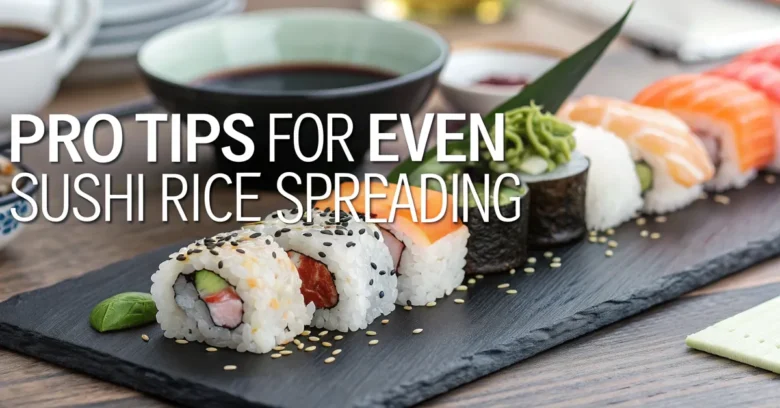Is spreading sushi rice evenly a tough task for you? You are not alone, as making the perfect sushi is a game of patience and skills, and most beginning sushi makers find themselves in a world of trouble when they try their hand at rice spreading.
If you are among those who find it difficult to spread rice, this article is for you, and you will come out with insights on how to spread rice on nori sheets like a professional.
Pro Tips for Even Sushi Rice Spreading
Perfect sushi starts with perfectly spread rice. Too thick, and it overpowers the other flavors. Too thin, and it falls apart. This guide gives you hands-on tips for even rice spreading, ensuring your homemade sushi rivals your favorite restaurant.
Why Even Rice Spreading Matters
Even rice spreading is key. Think of it as the canvas for your sushi art. The rice is not just a filler, it’s the base note of the dish. This is more than just a rule for perfection; it’s a rule for taste and mouthfeel.
- Texture: Uneven rice can lead to gummy spots and dry patches, messing up the overall feel.
- Flavor Balance: Too much rice drowns out the fish and veggies. Too little, and the flavors are out of sync.
- Roll Integrity: A solid, even layer helps the roll hold its shape, letting you cut clean pieces.
- Visual Appeal: Evenly spread rice looks better, adding to the dining experience.
Tools You’ll Need
Before you dive in, get your tools ready. These simple items can make a big difference in how easily you can manage the rice spreading process.
- Sushi Rice: Sushi rice is not like other kinds of rice, so be sure to use only short grain rice for making sushi.
- Nori Sheets: Ensure you have good quality nori seaweed sheets.
- Rice Paddle (Shamoji): A flat, wooden paddle is perfect for handling sushi rice without smashing it. Wood is best, as it does not react with the rice vinegar.
- Sushi Rolling Mat (Makisu): This helps to form the sushi rolls.
- Clean Water: Have a bowl of clean water handy.
- Vinegar Water (Tezu): Mix water with a bit of rice vinegar to keep the rice from sticking to your hands and paddle. A good ratio is 1 cup of water to 2 tablespoons of rice vinegar.
Prep Your Rice Right
The first step is proper rice prep. You can’t spread good sushi rice if the rice itself is not right.
- Wash the Rice: Wash your rice to remove extra starch. Rinse gently in cold water until the water is almost clear. This takes about three to four rinses.
- Cook the Rice: Use a rice cooker, if you have one, to cook your rice, or stovetop. Use a ratio of 1 cup of rice to 1.2 cups of water.
- Season the Rice: Once cooked, transfer the rice to a wooden bowl (hangiri). Gently mix in a seasoning of rice vinegar, sugar, and salt. A common ratio is 2 tablespoons of rice vinegar, 1 tablespoon of sugar, and 1/2 teaspoon of salt for every cup of uncooked rice.
Mastering the Rice Spreading Technique
Now, for the main act: rice spreading. Here are easy steps to get it right every single time.
- Prepare Your Hands: Dip your hands in vinegar water (tezu). This stops the rice from sticking to your fingers. Shake off the extra water so that your hands are moist and not dripping.
- Grab a Handful: Take a small, golf-ball-sized amount of rice. Don’t take too much at once; it’s easier to manage smaller amounts.
- Place on the Nori: Place the rice on the nori sheet, which should already be set on a sushi rolling mat. Nori sheets are usually shiny on one side and rough on the other. The rough side is where you need to spread the rice.
- Spread Gently: Use your fingertips and the rice paddle to spread the rice. Start from the center and work outwards. The key is to be gentle. Do not press hard; this will mash the rice.
- Maintain Even Thickness: Aim for a uniform layer of rice that’s about ¼ inch thick. Keep in mind that you should leave about half an inch to one inch of space on the far end of the nori sheet, as this will be needed to seal the roll.
- Fill in Gaps: Check for any thin spots or gaps and fill them in with small bits of rice.
- Keep Hands Wet: Re-wet your hands with vinegar water as needed to prevent sticking.
- Work Quickly: Work efficiently to prevent the nori from absorbing too much moisture from the rice, which makes it soggy.
Pro Tips for Perfect Rice Spreading
Here are some insider tricks from the sushi chefs themselves to make the rice spreading process even simpler.
- Use a Plastic Wrap: For those just starting out, you can put a sheet of plastic wrap over the nori. Spread the rice on top of the wrap. This keeps the nori dry and makes it easier to adjust the rice without tearing the nori.
- Don’t Overload: It’s better to use less rice than too much. You can always add more, but it’s hard to take away once it’s on the nori.
- Keep Your Paddle Clean: Use the vinegar water to keep your rice paddle clean. Sticky rice on the paddle can make spreading uneven.
- Feel the Rice: Pay attention to how the rice feels under your fingers. You’ll get a sense for the right amount and pressure as you practice.
- Practice Makes Perfect: Don’t get upset if your first few tries aren’t great. Like any skill, it takes practice. Keep at it, and you’ll soon get the feel of the rice and the right amount of pressure needed.
- Consider California Rolls First: If you find regular sushi too hard, you can start with California rolls, which have the rice on the outside. This way, you can master spreading rice perfectly before you start making other sushi.
Common Mistakes to Avoid
Even seasoned sushi makers sometimes slip up. Here are common mistakes to avoid when rice spreading.
- Using Too Much Rice: Overloading the nori with rice is a common mistake. Remember, the rice should complement, not overpower, the other ingredients.
- Pressing Too Hard: Pressing too hard will mash the rice and make it gummy. Gentle is the key.
- Not Using Vinegar Water: Not using vinegar water is a recipe for sticky disaster. Keep your hands and paddle moist at all times.
- Uneven Distribution: Failing to spread the rice evenly can lead to rolls that fall apart or taste unbalanced. Take your time and make sure the rice is uniform across the nori.
- Ignoring the Nori: Neglecting the quality of the nori can affect the final product. Make sure your nori is fresh and crisp.
Troubleshooting Tips
Sometimes, even when you do everything right, things can still go wrong. Here’s how to handle some common rice spreading problems.
- Rice is Too Sticky: If your rice is too sticky, try using a bit less water when cooking it. Also, ensure you’re using the right type of rice (sushi rice).
- Nori Tears Easily: If your nori tears easily, it could be too old or exposed to moisture. Store your nori in a cool, dry place in an airtight container.
- Rolls Fall Apart: If your rolls fall apart, it could be due to uneven rice distribution, too little rice, or not sealing the roll properly. Make sure you leave enough space at the end of the nori to seal the roll.
- Rice is Too Dry: If your rice seems too dry, try adding a bit more rice vinegar seasoning. Make sure to mix it gently so you don’t mash the rice.
Advanced Techniques
Once you’ve mastered the basics, you can try some advanced techniques to elevate your sushi game.
- Inside-Out Rolls (Uramaki): These rolls have the rice on the outside. To make them, spread the rice evenly over a sheet of plastic wrap on your rolling mat. Flip the nori onto the rice, then add your fillings. Use the rolling mat to form the roll, peeling away the plastic wrap as you go.
- Nigiri Sushi: For nigiri, you’ll need to form small, oblong mounds of rice by hand. Dip your hands in vinegar water, then gently shape the rice. Top with a slice of fish or other topping.
- Temaki (Hand Rolls): Temaki are cone-shaped rolls that are easy to make and eat. Simply spread a thin layer of rice over half of a nori sheet, add your fillings, and roll into a cone.
Seasoning Variations
While the standard rice vinegar seasoning is a classic, feel free to experiment with other flavor combinations to make your sushi unique.
- Yuzu Vinegar: Substitute rice vinegar with yuzu vinegar for a citrusy twist.
- Ginger Infusion: Add a few slices of ginger to your rice vinegar seasoning for a warm, spicy note.
- Sesame Oil: A dash of sesame oil can add depth and richness to your sushi rice.
- Spicy Mayo: Mix mayo with sriracha or chili oil for a spicy kick. Drizzle over your rolls before serving.
Expert Advice
To provide expertise to you, here are some advice from professional sushi chefs for rice spreading.
- Respect the Rice: “Sushi rice is not just any rice. It’s a delicate balance of flavors and textures,” says Chef Hiroki, a sushi chef. “Handle it with care and respect.”
- Use Quality Ingredients: “The best sushi starts with the best ingredients,” says Chef Aiko. Use fresh fish, high-quality nori, and properly seasoned rice.
- Keep it Simple: “Don’t overcomplicate things,” says Chef Kenji. “Focus on mastering the basics, and the rest will fall into place.”
- Practice Regularly: “Like any skill, making sushi takes practice,” says Chef Hana. “Don’t get discouraged if your first few attempts aren’t perfect. Keep practicing, and you’ll get there.”
Recipes to Try
Now that you know how to spread sushi rice, here are a few recipes you can try at home:
Classic California Roll
Ingredients:
- Sushi rice
- Nori sheets
- Avocado
- Cucumber
- Crab meat (or imitation crab)
- Sesame seeds (optional)
Instructions:
- Spread a thin layer of rice over the nori sheet.
- Flip the nori over so the rice is facing down.
- Add avocado, cucumber, and crab meat to the center of the nori.
- Roll tightly using a sushi rolling mat.
- Sprinkle with sesame seeds if desired.
- Slice and serve.
Spicy Tuna Roll
Ingredients:
- Sushi rice
- Nori sheets
- Tuna (sushi-grade)
- Spicy mayo (mayo mixed with sriracha)
- Avocado
- Cucumber
Instructions:
- Spread a thin layer of rice over the nori sheet.
- Flip the nori over so the rice is facing down.
- Add tuna, spicy mayo, avocado, and cucumber to the center of the nori.
- Roll tightly using a sushi rolling mat.
- Slice and serve.
Vegetarian Avocado Roll
Ingredients:
- Sushi rice
- Nori sheets
- Avocado
- Cucumber
- Carrot
- Cream cheese (optional)
Instructions:
- Spread a thin layer of rice over the nori sheet.
- Add avocado, cucumber, carrot, and cream cheese (if using) to the center of the nori.
- Roll tightly using a sushi rolling mat.
- Slice and serve.
The Art of Sushi Rice
Crafting sushi is a skill that marries technical know-how with a deep respect for tradition. Even rice spreading is the gateway to creating sushi that delights both the palate and the eye. With the right techniques, tools, and mindset, anyone can master this art form and bring the flavors of Japan to their own kitchen.



